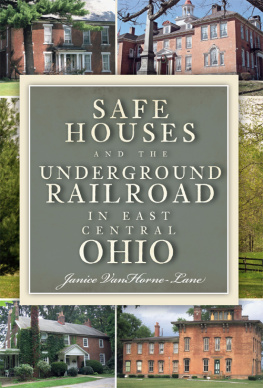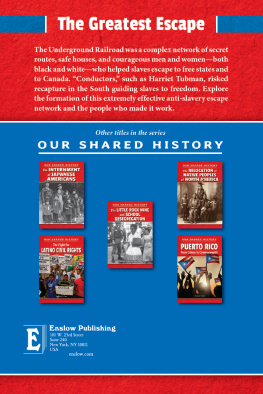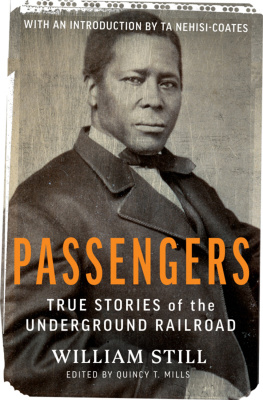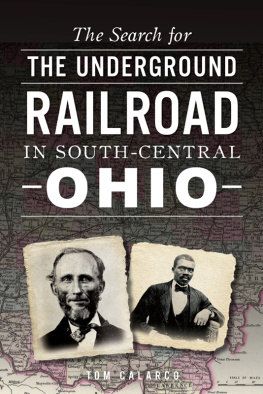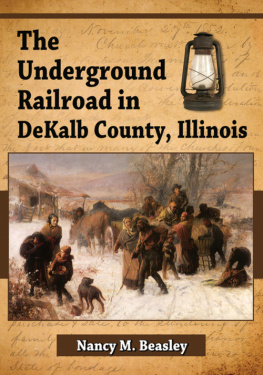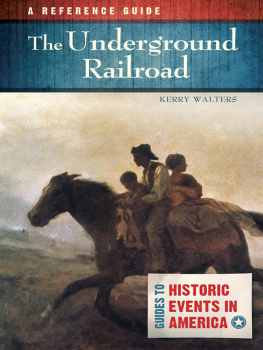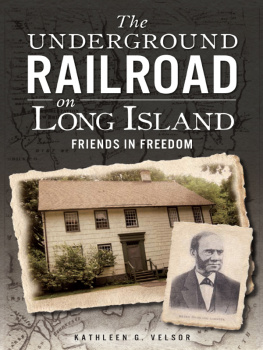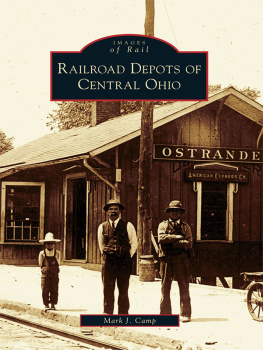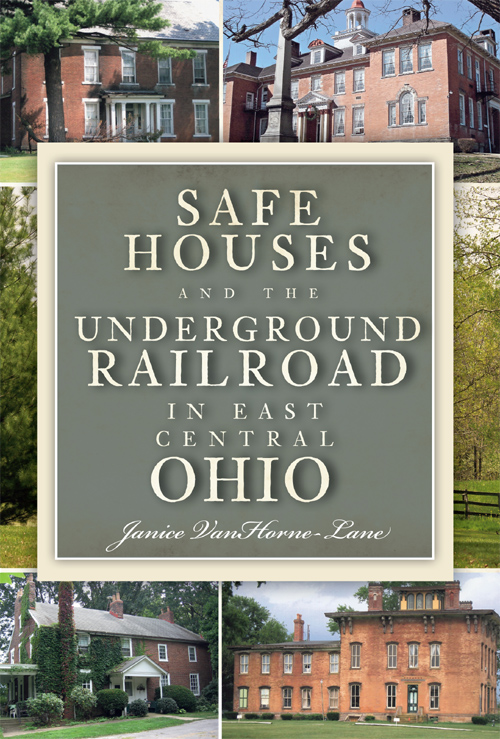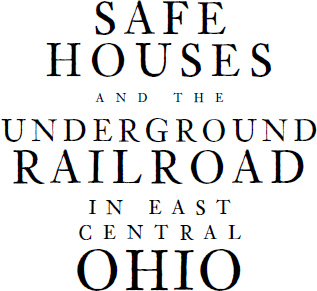
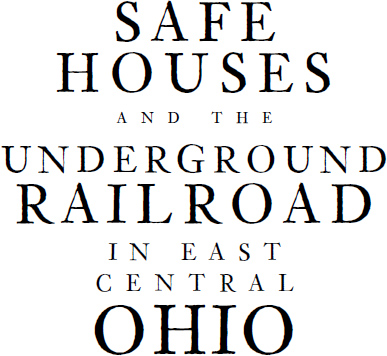
Janice VanHorne-Lane

Published by The History Press
Charleston, SC 29403
www.historypress.net
Copyright 2010 by Janice VanHorne-Lane
All rights reserved
First published 2010
e-book edition 2011
ISBN 978.1.61423.212.4
Library of Congress Cataloging-in-Publication Data
VanHorne-Lane, Janice.
Safe houses and the Underground Railroad in east central Ohio / Janice VanHorne-Lane.
p. cm.
Includes bibliographical references.
print edition ISBN 978-1-59629-246-8
1. Underground Railroad--Ohio. 2. Fugitive slaves--Homes and haunts--Ohio--History--19th century. 3. Abolitionists--Homes and haunts--Ohio--History--19th century. 4. Hiding places--Ohio--History--19th century. 5. Dwellings--Ohio--History--19th century. 6. Historic buildings--Ohio--History--19th century. 7. Ohio--History, Local. 8. Ohio--Race relations--History--19th century. 9. Ohio--Biography. I. Title.
E450.V3 2010
977.103--dc22
2010040135
Notice: The information in this book is true and complete to the best of our knowledge. It is offered without guarantee on the part of the author or The History Press. The author and The History Press disclaim all liability in connection with the use of this book.
All rights reserved. No part of this book may be reproduced or transmitted in any form whatsoever without prior written permission from the publisher except in the case of brief quotations embodied in critical articles and reviews.
A CKNOWLEDGEMENTS
It is always a pleasure to get to know so many great folks when working on a project like this. Over the past year, I was able to tour many homes, restaurants and museums, and if I tried to list everyone and thank them individually, I am certain I would either forget someone or not be able to thank them enough. Having enough pages to fit all the thank-yous would be quite impossible. It is with great thankfulness to each of you that this book came about. Your generous gift of your time and photos made this work possible. Since I cannot begin to name everyone here, know that I thank you each in my heart.
I do want to thank all the historical societies, genealogical societies, e-mail lists, museum directors, photographers (both professional and amateur), my wonderful friends who proofread and kept me on track and the kind souls who gave me directions. You all know who you are! I especially want to thank the homeowners who so graciously allowed me and my family to tour their homes when we dropped by unexpectedly, but I ask the readers to please respect privacy and enjoy the homes from afar.
My family was very kind in their patience while this work was being put together. Thank you for riding along on so many house-hunting adventures, the long hours in the car and your understanding while I focused more on this than on you. I love you! I especially want to thank my husband, Nathan, for being my photographer on this project. The photos that are marked, N8 were taken by him, and that is his signature.
To you, the reader, thank you for taking time to read this page, as well as the rest of the book. May you enjoy!
I NTRODUCTION
Hide-and-seek is a game loved by nearly everyone and played by children of all ages, but when you are hiding for your life because those seeking you want to return you to a life of slavery, it is not fun and games. For many decades, namely the late 1700s and most of the 1800s, those who had been held as slaves sought their freedom. One way of doing so was to escape and make their way to Mexico, Cuba, Canada or elsewhere outside the United States. The route was so mysterious to the slave owners seeking to reclaim their property that it became known as the Underground Railroad.
It is important to know that the Underground Railroad was neither underground nor an actual railroad. The terminology has several legends detailing how it came to be, but in the one told most often, a fugitive slave escaped from his master in Kentucky and made it to the Ohio River across from Ripley, Ohio. While the slave swam for his life, the owner searched for a boat in which to row after him. The slave vanished from view, and the owner searched to no avail. He eventually gave up and, in his frustration, concluded that it was as though the slave had gone off on an underground railroad. Whether this is true, the terminology stuck, and various railroad terms were soon associated with this system. The Underground Railroad was the route taken by fugitives.Conductors were the people who allowed fugitives to stay on their property. Stationmasters were those who simply aided a fugitive in his travels from one point to another.
While the accepted term is Underground Railroad, magician seems to be a more accurate term. Magicians pride themselves in the art of misdirection. While the audience is looking one way, they are doing something else in the other direction. This seems to be what happened more often than not with fugitives. While slave hunters were searching one part of the house or property, fugitives were being escorted away in another direction. Upon seeing the homes from that time period and their massive amount of rooms, this would seem to have been quite easy. Typically, there were two or more staircases and often as many as five exterior doors in each home. Closets or secret areas may have simply been used as decoys to distract those doing the searching. No matter what it was called, we do know that slaves ran away, and there were many people who felt the moral obligation to help.
It is important to remember that it was not just rich white men who were conductors. Often, women, children and freed slaves were just as involved. Many fugitives felt safer approaching someone of their own background, but it soon became common to seek out those of the Quaker faith. Their recognizable clothes not only let fugitives know who they were but also worked as a disguise in many instances.
Many of the homes still standing were built by those of the Quaker faith who came to settle Ohio. The industrial age that followed the Civil War led to rapid urban development, and during this time many of the Underground Railroad sites were torn down.
Since the time of the Underground Railroads operation, many stories have been perpetuated about the places and people who were involved. Nearly two hundred years later, it is almost impossible to know for certain whether a house, barn, cave or other building was truly a hiding place for those seeking their freedom. The first thing to take into consideration is the year the site was built. Anything built after 1865 would not have been used, as there was no need for hiding once the Thirteenth Amendment gave slaves their freedom. If a house was built after that time, it is more likely that it was involved in Prohibition.
Another indication is proximity to known routes. Many communities have at least one place that has been historically identified for involvement. Using these sites and maps from the early 1800s as guides, it is possible to determine where the routes were located.
The next indicator of legitimate involvement is the way a place was built; secret staircases, rooms accessible only by secret doors or tunnels dug to other locations are a few clues. Many houses known to have been involved have similarities in their architecture, mainly from being built in the same time period. Yet without the operators of that time here to tell us, it is all speculation.

